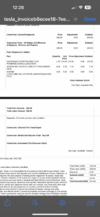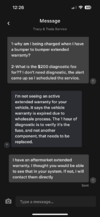About 2 weeks ago, a warning appeared on my console with the following message, which would not go away under any circumstances:
Battery fuse requires replacement soon
OK to drive - Schedule service

Not knowing what it was, I did some searching. There's not a whole lot of info about what it is or what it does. Some say it's a non-powered fuse and has to get replaced with powered fuse. Some mix it with Pyro fuse which after much research, seems to be a different thing.
I scheduled service through the app and Tesla's Mobile Service showed up after a couple of days. Technician said that it's just a reconfiguration of the system and nothing needs to be replaced. He plugged in his laptop to the car, went into "Service Plus" mode and cleared the warning. But he did say that I wasn't even supposed to see that message. Don't know exactly what that means, but probably something in the last OTA update flipped a flag on an internal config and it has to be changed locally by a technician. Just a guess on my part. I found just 1 picture of the "Service mode" on Model S which said that "Battery fuse needs to be replaced by x date", somewhat like an expiration date, but there was no other explanation.
All is well now, but I wanted to share with you that if you see this annoying message, nothing needs to be replaced and the issue will go away after a 5 minute visit by a technician.
Battery fuse requires replacement soon
OK to drive - Schedule service
Not knowing what it was, I did some searching. There's not a whole lot of info about what it is or what it does. Some say it's a non-powered fuse and has to get replaced with powered fuse. Some mix it with Pyro fuse which after much research, seems to be a different thing.
I scheduled service through the app and Tesla's Mobile Service showed up after a couple of days. Technician said that it's just a reconfiguration of the system and nothing needs to be replaced. He plugged in his laptop to the car, went into "Service Plus" mode and cleared the warning. But he did say that I wasn't even supposed to see that message. Don't know exactly what that means, but probably something in the last OTA update flipped a flag on an internal config and it has to be changed locally by a technician. Just a guess on my part. I found just 1 picture of the "Service mode" on Model S which said that "Battery fuse needs to be replaced by x date", somewhat like an expiration date, but there was no other explanation.
All is well now, but I wanted to share with you that if you see this annoying message, nothing needs to be replaced and the issue will go away after a 5 minute visit by a technician.




